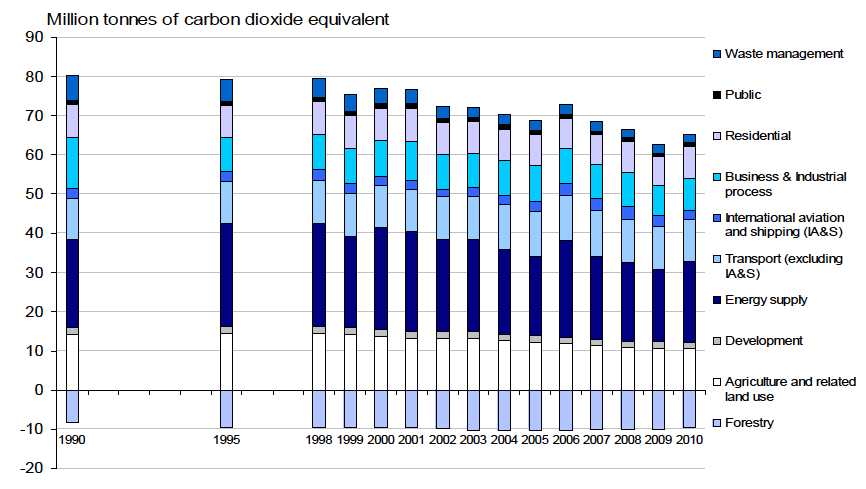Key Scottish Environment Statistics 2012
This publication aims to provide an easily accessible reference document which offers information on a wide range of environmental topics. It covers key datasets on the state of the environment in Scotland, with an emphasis on the trends over time wherever possible.
This document is part of a collection
Greenhouse Gas Emissions by SourceR,[9],[10],[12]: 1990-2010
Greenhouse gas emissions taking account of emissions and removals (MtCO2e)[11]

It should be noted that improved data sources and estimation techniques have routinely led to revision of historic greenhouse gas emission estimates. All data has been revised to reflect these changes.
Greenhouse gases (GHGs) in the atmosphere help to retain radiative energy, resulting in warming of the lower atmosphere and earth surface. Atmospheric concentrations of GHGs have increased as a result of human activities since the Industrial Revolution (c.1750). This has enhanced the greenhouse effect and is influencing global climate change.[13]
Scotland's emissions of greenhouse gases in 2010 were 55.7 million tonnes of carbon dioxide equivalent (MtCO2e), 5.8% (3.1 MtCO2e) higher than 2009 and 22.8% (16.4 MtCO2e) below 1990 levels. [14],[15],[16] Between 2009 and 2010, there were large increases in greenhouse gas emissions in the energy supply and residential sectors primarily due to a rise in fossil fuel heating in the residential sector, combined with an increase in electricity generation from coal fired power stations. 2010 was, on average, the 10th coldest in the period since 1910.
The energy supply sector was the largest emitter of GHG emissions in 2010, contributing 37.2% of the emissions in Scotland. Emissions from this sector were 11.9% higher than in 2009. Transport emissions contributed 19.2% to the 2010 total, and while they have increased by 2.7% since 1990, in 2010 they were 0.5% lower than in 2009. The agriculture and related land use sector accounted for 18.8% of total emissions in 2010, a decrease of 2.6% since 2009. Forestry has represented a net removal of GHGs since 1990 and this net removal reduced in size by 4.1% from 2009 to 2010.
Emissions from the residential and business and industrial process sectors contributed 15.0% and 14.2% of the total respectively. Residential emissions have increased by 2.7% since 1990, and are up 14.6% from 2009 levels.
Source: National Atmospheric Emissions Inventory[17] / Scottish Government[18] / Metadata
Contact
Email: Sandy McPhee
There is a problem
Thanks for your feedback